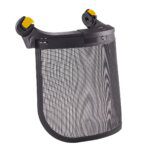What is PPE?

A Comprehensive Guide to Personal Protective Equipment
Personal Protective Equipment, commonly known as PPE, is any gear or clothing designed to protect individuals from health and safety hazards in the workplace or during specific activities. PPE plays a crucial role in minimizing exposure to risks such as physical injuries, chemical exposures, and airborne particles, making it an essential component in many industries.
In this article, we’ll dive into what PPE is, its types, importance, and how it is used across various sectors. We’ll also provide useful backlinks to additional resources for further reading.
What is PPE?
PPE stands for Personal Protective Equipment, and it includes a wide range of safety gear that individuals wear or use to protect themselves from potential hazards. PPE is essential in industries such as construction, manufacturing, healthcare, and rope access, where workers are exposed to risks that could result in injury or illness.
Common Types of PPE
Head Protection: Helmets or hard hats protect against falling objects or head injuries in construction, industrial, or rope access work.
Eye and Face Protection: Safety glasses, goggles, and face shields prevent injury from flying particles, chemicals, or sparks.
Hearing Protection: Earplugs and earmuffs reduce the risk of hearing damage caused by high noise levels, common in industrial settings.

Respiratory Protection: Masks and respirators are designed to protect against inhaling harmful dust, fumes, gases, or airborne pathogens.
Hand Protection: Gloves protect hands from burns, cuts, chemicals, and infections.
Hand Protection: Gloves protect hands from burns, cuts, chemicals, and infections.

Body Protection: Protective clothing, like coveralls or chemical suits, shields the body from hazardous materials or extreme temperatures.

Fall Protection: Harnesses, lanyards, and anchor points are used in rope access, construction, or tower climbing to prevent falls from height.
Why is PPE Important?
The primary function of PPE is to minimize the exposure to hazards that can cause serious injuries or illnesses. While engineering controls and safety protocols are important, PPE acts as the final barrier between workers and the risk of harm.
Key Benefits of PPE:
Reduces the Risk of Injury: PPE ensures that workers are shielded from the physical dangers of their jobs, such as impact from falling objects, exposure to harmful substances, or risks of cuts and abrasions.
Prevents Illnesses: In healthcare settings, PPE like masks, gloves, and gowns prevent the spread of infectious diseases, ensuring both patient and healthcare worker safety.
Ensures Compliance with Regulations: Many industries are required by law to provide adequate PPE to their employees. Ensuring workers have the necessary equipment helps businesses stay compliant with occupational safety regulations, such as those enforced by OSHA (Occupational Safety and Health Administration).
Boosts Worker Confidence: When workers feel protected, they are more likely to focus on their tasks and perform better, knowing that their safety is prioritized.
Common Industries and Uses of PPE
Construction and Industrial Work: In construction, PPE like hard hats, safety boots, and high-visibility vests are essential to prevent injury from machinery, falls, or falling debris.
Healthcare: Healthcare workers use PPE such as gloves, masks, face shields, and gowns to prevent the spread of diseases and protect themselves from exposure to pathogens.
Manufacturing: In factories or manufacturing plants, PPE includes safety glasses, ear protection, and gloves to protect workers from mechanical injuries, loud noises, or chemical exposure.
Rope Access and High-Risk Jobs: Rope access technicians rely heavily on PPE like harnesses, helmets, and gloves to protect themselves while working at heights.
Laboratories: Lab technicians wear lab coats, goggles, gloves, and sometimes respirators to protect against chemicals, biological agents, and radioactive materials.
Best Practices for Using PPE
Proper Fit and Comfort: PPE should fit properly to be effective. Ill-fitting equipment can lead to reduced protection or even increased risk of injury. For example, loose gloves might get caught in machinery, while oversized helmets may slip off during use.
Regular Inspection: PPE should be regularly inspected for wear and tear. Damaged or expired equipment should be replaced immediately. For example, respirators must be checked to ensure filters are not clogged or damaged.
Training and Education: Workers should be trained in the proper use and maintenance of PPE. Without the right knowledge, even the best equipment can fail to provide adequate protection. This is especially critical in industries like healthcare or construction, where risks are high.
Proper Storage: PPE must be stored correctly when not in use to avoid damage. For example, respirators should be kept in a clean, dry environment, and helmets should be stored away from sunlight and extreme heat.
Common Questions & Answers about PPE
Q: Why is PPE necessary if I follow safety protocols?
A: While safety protocols are essential, they can’t eliminate all risks. PPE provides a final line of defense against hazards that other controls may not address.
Q: How do I know if my PPE fits correctly?
A: Proper fit is crucial. For helmets, ensure it sits snugly on your head and doesn’t shift. Gloves should fit securely without being too tight or too loose. For respirators, perform a seal check to ensure no air leaks.
Q: Is PPE reusable?
A: Some PPE, like hard hats and safety goggles, can be reused after cleaning and inspection. However, single-use items like disposable gloves and masks should be discarded after each use to prevent contamination.
Q: Can PPE be shared between workers?
A: PPE that comes in direct contact with skin or bodily fluids, such as gloves, respirators, or hearing protection, should not be shared. Shared PPE must be cleaned and disinfected between uses.
Relevant Links
- OSHA (Occupational Safety and Health Administration) – PPE Standards
- CDC (Centers for Disease Control and Prevention) – Personal Protective Equipment
- WHO (World Health Organization) – Personal Protective Equipment (PPE)
- SPRAT (Society of Professional Rope Access Technicians) – Safety and PPE Guidelines
- IRATA (Industrial Rope Access Trade Association) – PPE Guidelines for Technicians
- PETZL (What is PPE)
Share this article:






